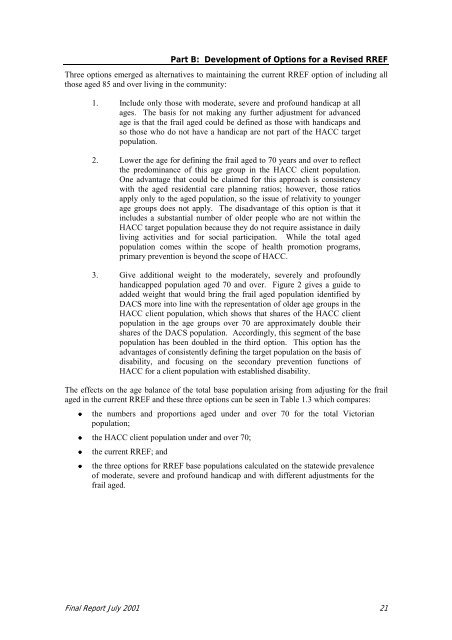Final Report on RREF 2001 - Department of Health
Final Report on RREF 2001 - Department of Health
Final Report on RREF 2001 - Department of Health
Create successful ePaper yourself
Turn your PDF publications into a flip-book with our unique Google optimized e-Paper software.
Part B: Development <strong>of</strong> Opti<strong>on</strong>s for a Revised <strong>RREF</strong><br />
Three opti<strong>on</strong>s emerged as alternatives to maintaining the current <strong>RREF</strong> opti<strong>on</strong> <strong>of</strong> including all<br />
those aged 85 and over living in the community:<br />
1. Include <strong>on</strong>ly those with moderate, severe and pr<strong>of</strong>ound handicap at all<br />
ages. The basis for not making any further adjustment for advanced<br />
age is that the frail aged could be defined as those with handicaps and<br />
so those who do not have a handicap are not part <strong>of</strong> the HACC target<br />
populati<strong>on</strong>.<br />
2. Lower the age for defining the frail aged to 70 years and over to reflect<br />
the predominance <strong>of</strong> this age group in the HACC client populati<strong>on</strong>.<br />
One advantage that could be claimed for this approach is c<strong>on</strong>sistency<br />
with the aged residential care planning ratios; however, those ratios<br />
apply <strong>on</strong>ly to the aged populati<strong>on</strong>, so the issue <strong>of</strong> relativity to younger<br />
age groups does not apply. The disadvantage <strong>of</strong> this opti<strong>on</strong> is that it<br />
includes a substantial number <strong>of</strong> older people who are not within the<br />
HACC target populati<strong>on</strong> because they do not require assistance in daily<br />
living activities and for social participati<strong>on</strong>. While the total aged<br />
populati<strong>on</strong> comes within the scope <strong>of</strong> health promoti<strong>on</strong> programs,<br />
primary preventi<strong>on</strong> is bey<strong>on</strong>d the scope <strong>of</strong> HACC.<br />
3. Give additi<strong>on</strong>al weight to the moderately, severely and pr<strong>of</strong>oundly<br />
handicapped populati<strong>on</strong> aged 70 and over. Figure 2 gives a guide to<br />
added weight that would bring the frail aged populati<strong>on</strong> identified by<br />
DACS more into line with the representati<strong>on</strong> <strong>of</strong> older age groups in the<br />
HACC client populati<strong>on</strong>, which shows that shares <strong>of</strong> the HACC client<br />
populati<strong>on</strong> in the age groups over 70 are approximately double their<br />
shares <strong>of</strong> the DACS populati<strong>on</strong>. Accordingly, this segment <strong>of</strong> the base<br />
populati<strong>on</strong> has been doubled in the third opti<strong>on</strong>. This opti<strong>on</strong> has the<br />
advantages <strong>of</strong> c<strong>on</strong>sistently defining the target populati<strong>on</strong> <strong>on</strong> the basis <strong>of</strong><br />
disability, and focusing <strong>on</strong> the sec<strong>on</strong>dary preventi<strong>on</strong> functi<strong>on</strong>s <strong>of</strong><br />
HACC for a client populati<strong>on</strong> with established disability.<br />
The effects <strong>on</strong> the age balance <strong>of</strong> the total base populati<strong>on</strong> arising from adjusting for the frail<br />
aged in the current <strong>RREF</strong> and these three opti<strong>on</strong>s can be seen in Table 1.3 which compares:<br />
• the numbers and proporti<strong>on</strong>s aged under and over 70 for the total Victorian<br />
populati<strong>on</strong>;<br />
• the HACC client populati<strong>on</strong> under and over 70;<br />
• the current <strong>RREF</strong>; and<br />
• the three opti<strong>on</strong>s for <strong>RREF</strong> base populati<strong>on</strong>s calculated <strong>on</strong> the statewide prevalence<br />
<strong>of</strong> moderate, severe and pr<strong>of</strong>ound handicap and with different adjustments for the<br />
frail aged.<br />
<str<strong>on</strong>g>Final</str<strong>on</strong>g> <str<strong>on</strong>g>Report</str<strong>on</strong>g> July <strong>2001</strong> 21
















